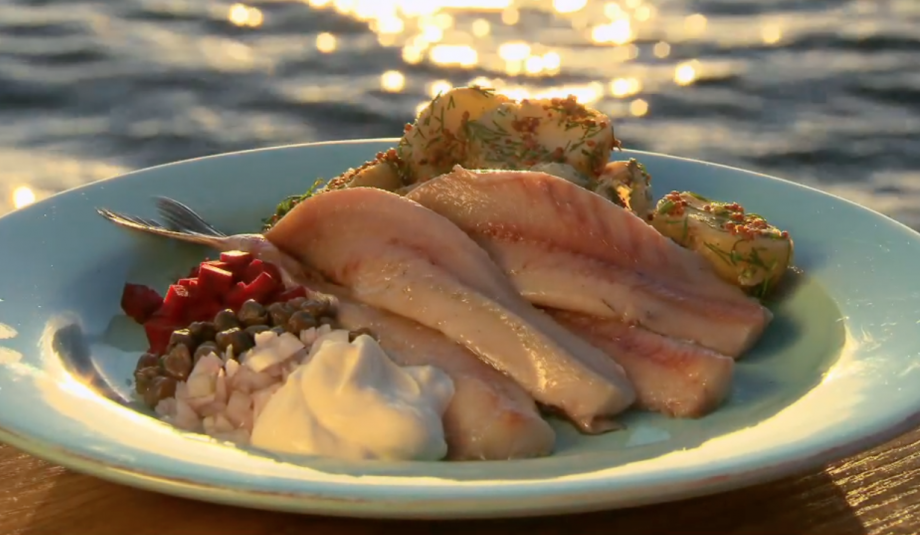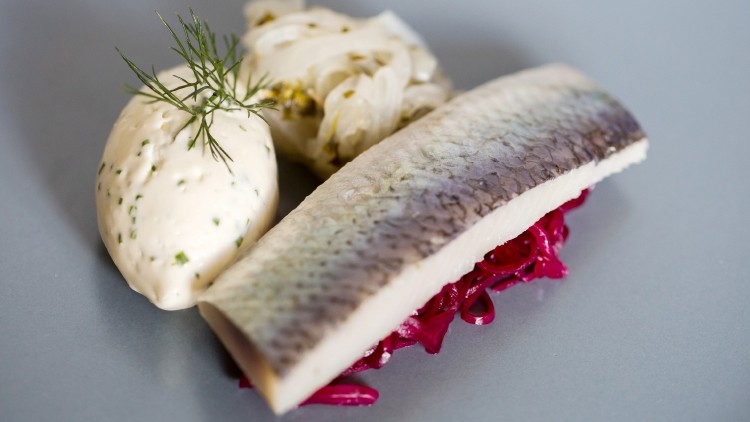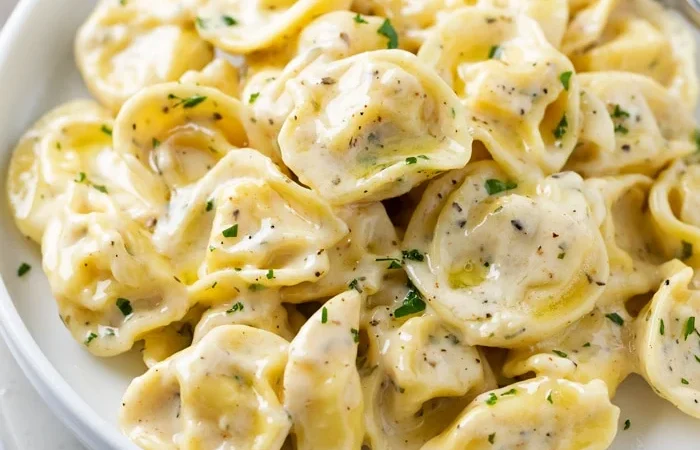Soused herring, or “maatjes” in Dutch, is a traditional Dutch delicacy that has been enjoyed for centuries. This article explores the origins, preparation, and cultural significance of soused herring, a beloved dish in the Netherlands.

Origins and History:
Contents
Soused herring has been a staple of Dutch cuisine since the 14th century. The herring fishing industry flourished in the Netherlands during the Middle Ages, and preserving herring in barrels with a marinade of vinegar, salt, and spices became a popular method of preparation.
Preparation:
To prepare soused herring, fresh herring fillets are gutted and cleaned, then soaked in a marinade consisting of water, vinegar, sugar, salt, and spices such as peppercorns, bay leaves, and onions. The herring is left to marinate for several days, allowing the flavors to meld and the fish to become tender and flavorful.
Serving and Presentation:
Soused herring is typically served chilled, either whole or filleted, often accompanied by chopped onions and pickles. It is traditionally eaten with the hands, holding the fish by the tail and taking small, delicate bites. In the Netherlands, soused herring is enjoyed as a street food snack or as part of a larger meal.
Cultural Significance:
Soused herring holds a special place in Dutch culinary culture, symbolizing tradition, heritage, and maritime pride. It is an integral part of Dutch festivals and celebrations, such as “Vlaggetjesdag” (Flag Day), which marks the beginning of the herring season and features festivities centered around the fishing industry.
Health Benefits:
Herring is rich in omega-3 fatty acids, protein, and vitamin D, making soused herring not only delicious but also nutritious. Omega-3 fatty acids are known for their heart-healthy benefits, while vitamin D is essential for bone health and immune function.
Variations:
While traditional soused herring is marinated in a vinegar-based brine, there are many regional variations and creative interpretations of the dish. Some recipes incorporate different herbs and spices, while others may use alternative marinades or smoking methods to add depth of flavor.
Conclusion:
Soused herring is more than just a culinary delight; it is a symbol of Dutch heritage and a testament to the country’s rich maritime history. Whether enjoyed as a street food snack or as part of a festive feast, soused herring continues to captivate the taste buds and evoke a sense of tradition and nostalgia for generations of Dutch people and food enthusiasts worldwide slot anti rungkad.
Pros and Cons of Soused Herring: Exploring the Dutch Delicacy
Soused herring, a traditional Dutch dish, offers a unique blend of flavors and textures that has delighted palates for centuries. However, like any food, it comes with its own set of advantages and disadvantages. Let’s explore the pros and cons of enjoying this beloved delicacy:

Pros:
- Nutrient-Rich: Soused herring is a good source of omega-3 fatty acids, protein, and vitamin D, which contribute to heart health, muscle repair, and bone strength.
- Distinctive Flavor: The marinade of vinegar, salt, and spices infuses the herring with a tangy, savory taste that is both refreshing and satisfying.
- Cultural Tradition: Soused hering holds a significant place in Dutch culinary culture, symbolizing heritage, maritime pride, and communal celebration.
- Versatile: Soused herring can be enjoyed in various ways, whether served whole or filleted, as a street food snack, appetizer, or part of a larger meal.
- Convenient and Accessible: In the Netherlands, soused herring is readily available at fishmongers, street stalls, and supermarkets, making it a convenient option for locals and visitors alike.
Cons:
- Strong Flavor: The distinctive flavor of soused hering, characterized by its vinegar-based marinade, may not appeal to everyone’s palate, particularly those who prefer milder tastes.
- Odor: Soused herring has a strong aroma that some individuals may find off-putting, especially when consumed in enclosed spaces or public settings.
- Texture: The texture of soused herring, with its soft flesh and oily consistency, may not be to everyone’s liking, particularly those who prefer firmer, flakier fish.
- High Sodium Content: The pickling process used in preparing soused hering results in a high sodium content, which may be a concern for individuals with hypertension or those monitoring their salt intake.
- Environmental Considerations: The sustainability of herring fishing practices and the impact on marine ecosystems are important factors to consider when consuming soused herring on a large scale.
Conclusion:
While soused herring offers a flavorful and culturally significant culinary experience, it’s essential to consider both its pros and cons when enjoying this traditional Dutch delicacy. Whether savoring it for its nutritional benefits, cultural significance, or simply for the love of its distinctive taste, soused hering continues to captivate the palates of food enthusiasts around the world.
The Art of Crafting Soused Herring: A Traditional Dutch Delicacy
Soused herring, known as “maatjes” in Dutch, is a revered dish that embodies centuries-old culinary traditions in the Netherlands. This article provides insights into the meticulous process of creating soused hering, from sourcing the freshest fish to marinating them in a flavorful brine.

Selecting the Herring:
- Freshness Matters: The key to exceptional soused herring lies in selecting the freshest herring available. Fishermen catch herring during the spring season when they are at their peak quality and flavor.
- Quality Control: Experienced fishmongers carefully inspect the herring for freshness, appearance, and size, ensuring that only the finest specimens are chosen for the sousing process.
Gutting and Cleaning:
- Skilled Hands: Once the herring are selected, they undergo a meticulous gutting and cleaning process. Skilled fishmongers remove the entrails and clean the fish thoroughly, ensuring that they are ready for the next stage of preparation.
- Precision is Key: Gutting herring requires precision and attention to detail to preserve the integrity of the fish and prevent any contamination.
Marinating the Herring:
- Creating the Brine: The signature marinade for soused herring consists of a blend of vinegar, water, sugar, salt, and aromatic spices such as peppercorns, bay leaves, and onions.
- Immersion Process: The gutted and cleaned herring are immersed in the brine, allowing them to absorb the flavors and develop their characteristic tangy taste over time.
- Patience is a Virtue: The marinating process typically lasts several days, during which the herring undergo a gradual transformation, becoming tender and flavorful as they absorb the marinade.
Presentation and Serving:
- Chilled to Perfection: Once fully marinated, the soused herring is chilled to enhance its texture and flavor. It is often served whole or filleted, accompanied by chopped onions and pickles.
- Traditional Enjoyment: Soused herring is traditionally eaten with the hands, holding the fish by the tail and taking small, delicate bites to savor its unique taste and texture.
Conclusion:
Crafting soused herring is a time-honored tradition that requires skill, patience, and a deep appreciation for the art of preserving and enhancing the natural flavors of this beloved fish. From the careful selection of the freshest herring to the meticulous marinating process, every step is a testament to the rich culinary heritage of the Netherlands and the enduring appeal of soused herring as a cherished delicacy.
Read More Article About “AFRICAN HUNGER: A SILENT CRISIS UNFOLDING ACROSS THE CONTINENT“





